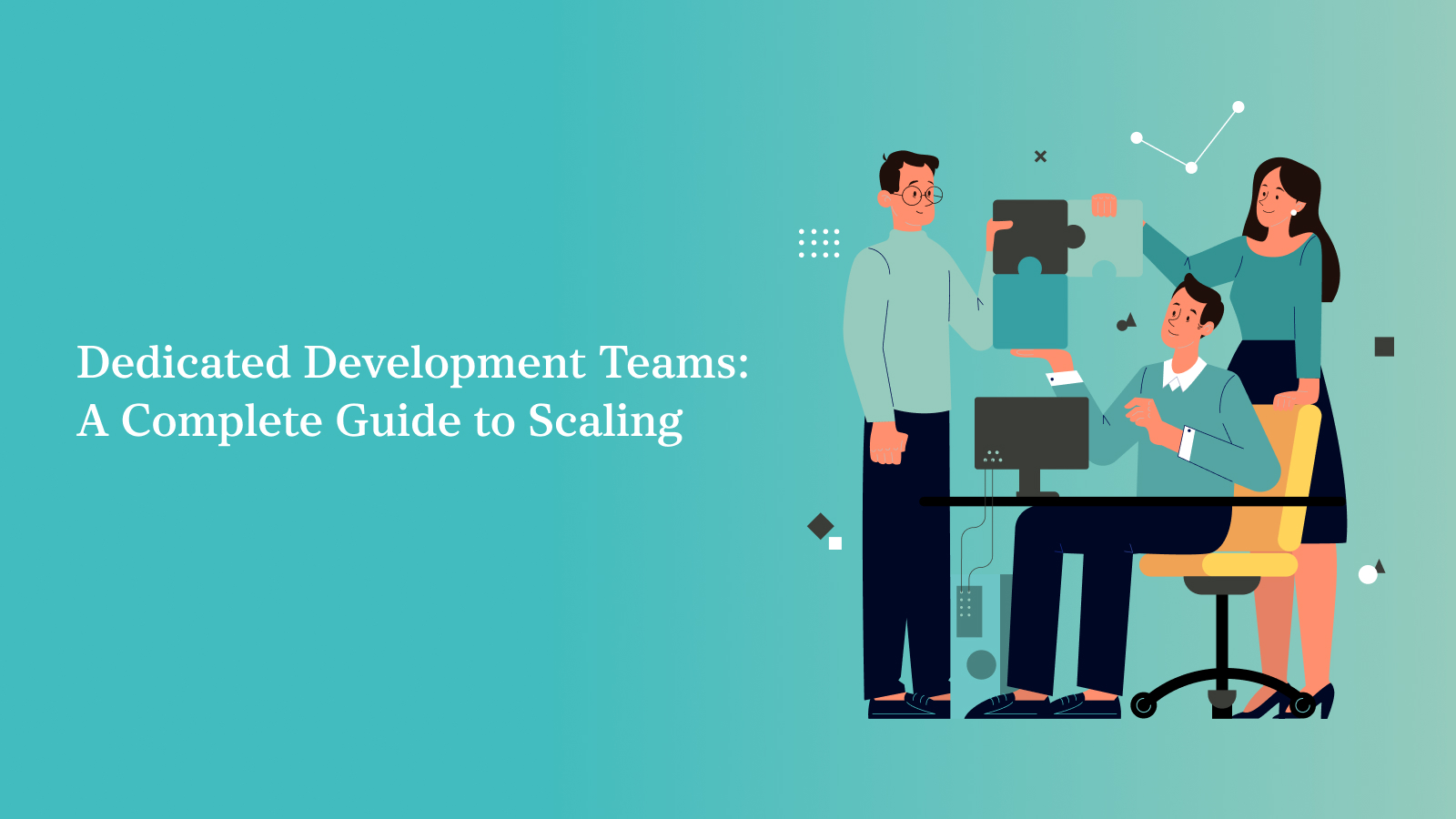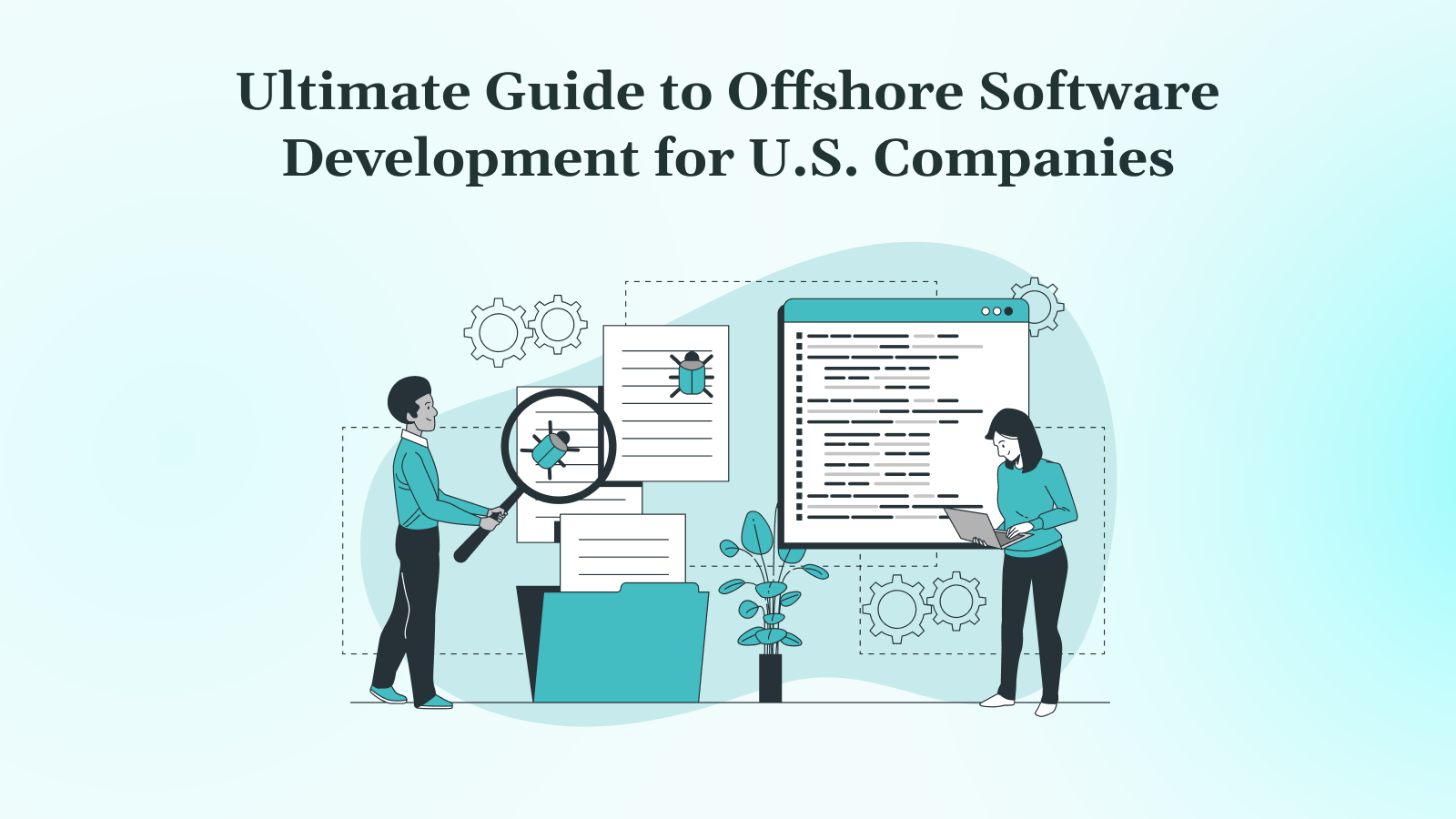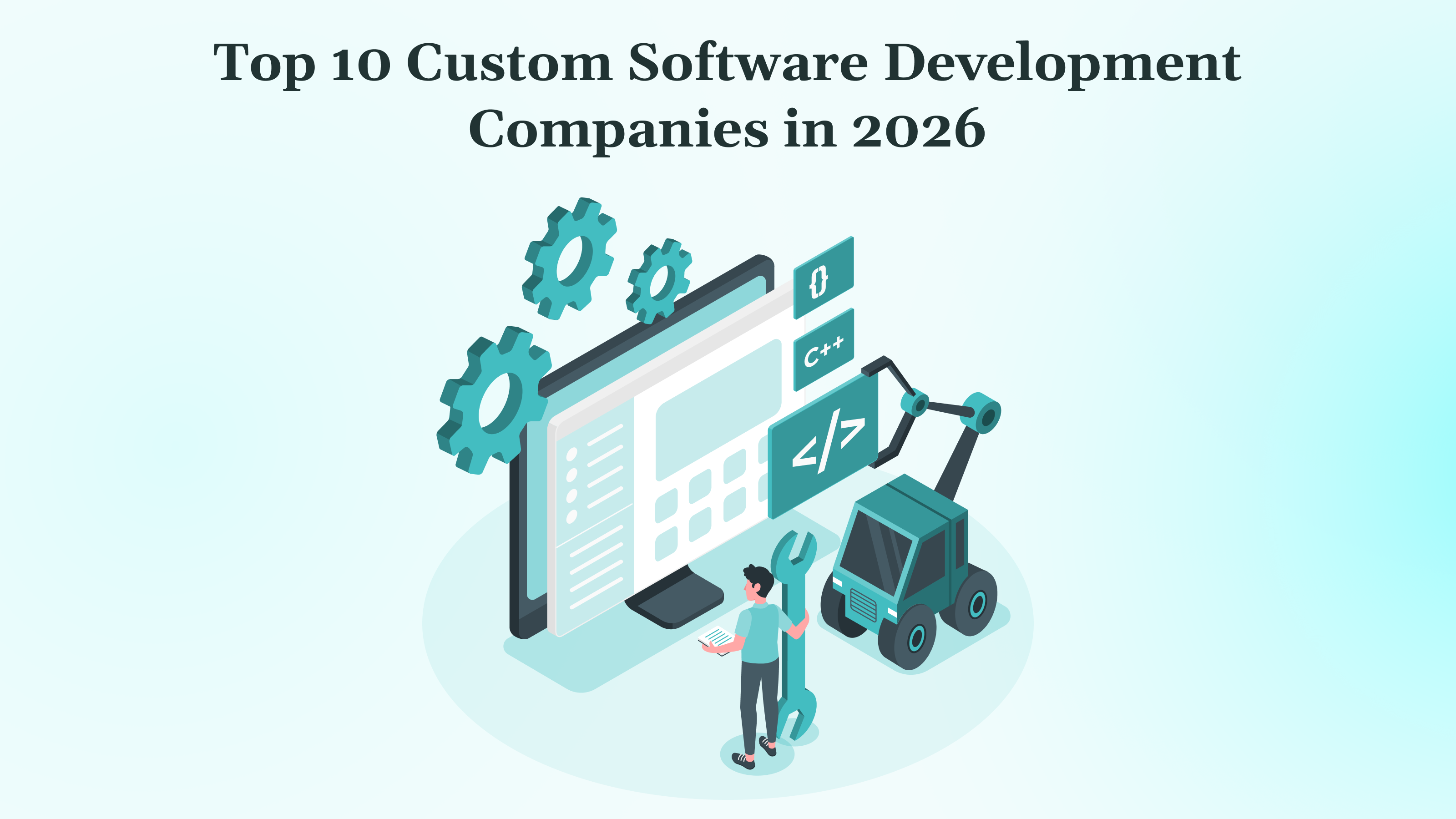Your engineering roadmap demands speed, specialization, and long-term stability. However, when internal hiring takes months, and outsourcing creates delivery gaps, the cost of delay compounds rapidly. So, how do you scale efficiently without compromising quality, control, or compliance?
For many high-growth teams, the answer is a dedicated development team comprising engineers who integrate long-term solutions without adding overhead.
In this guide, we will break down what dedicated development teams are, how they work, and where they fit in your growth strategy. You will gain clear, practical insights into cost, quality, structure, and long-term value, enabling you to determine whether the model aligns with your business needs.
Key Takeaways
- Dedicated teams give you long-term engineering capacity without the delays or overhead of internal hiring.
- The model works best when delivery speed, quality retention, and product context matter more than hourly cost.
- Your team structure must align with your tech stack, product stage, and compliance needs to avoid bottlenecks later.
- Vendor depth is evident in execution, as demonstrated by code quality practices, communication routines, and architectural ownership.
- Scaling with the right team reduces product risk, speeds time-to-market, and keeps internal bandwidth focused on strategy.
Defining the Dedicated Development Team Model
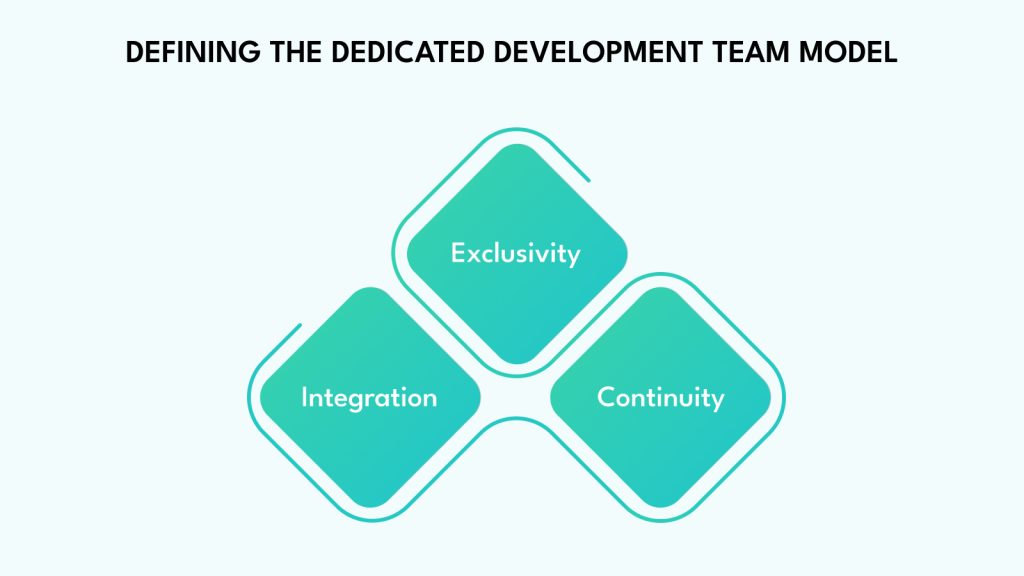
A dedicated development team is a full-time, remote extension of your internal engineering force. These professionals, developers, testers, DevOps engineers, and technical leads operate exclusively on your project, integrating directly with your workflows, toolchains, and development standards.
They participate in sprint planning, contribute to architectural decisions, follow your branching strategy, and uphold your documentation practices. What makes this model distinct is its ability to maintain long-term knowledge retention and ensure continuity of delivery. The team builds deeper understanding over time, reduces handoff friction, and makes decisions based on your roadmap.
The model operates on three foundational principles:
- Exclusivity means the team works solely on your project, with no shared resources or competing priorities.
- Integration ensures they use your tools, follow your processes, and align with your technical standards.
- Continuity ensures that knowledge is accumulated within the team, reducing ramp-up time for new features and eliminating the context loss that often plagues project-based outsourcing.
This approach bridges the gap between the high cost and slow pace of internal hiring and the lack of control inherent in traditional outsourcing. You gain immediate access to skilled professionals who understand your business logic, technical constraints, and product vision.
When Should You Use a Dedicated Development Team?
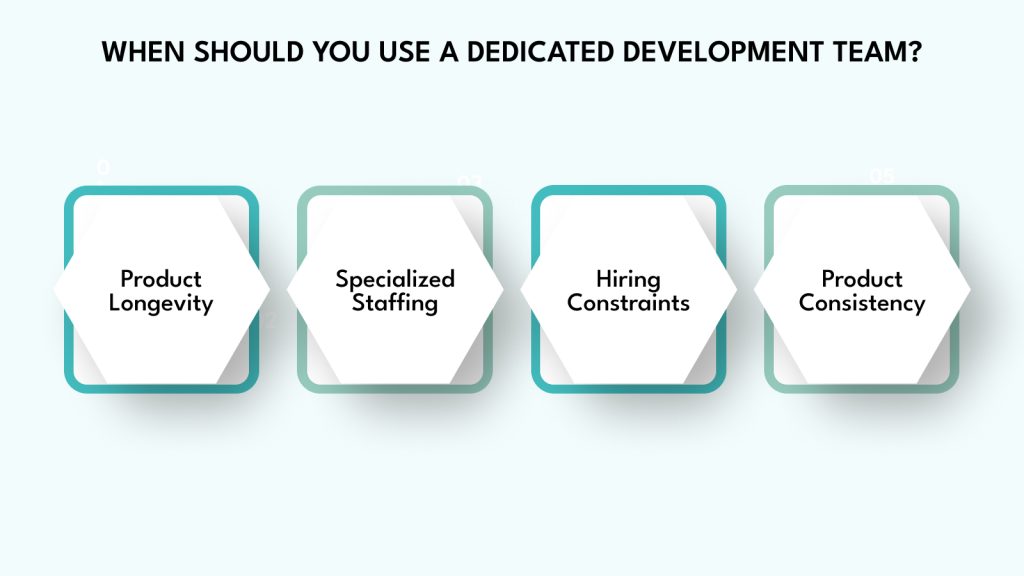
Dedicated teams are most effective when internal hiring creates delays, and traditional outsourcing lacks depth. Here are scenarios where they deliver measurable value:
Long-Term Product Development
If you are building a platform with evolving requirements, frequent releases, and long-term complexity, a dedicated team is a wise choice. They ensure consistent delivery and maintain a stable and reliable platform. The team retains context across sprints, manages technical debt gradually, and improves performance over time.
Consider SaaS platforms that require ongoing feature development, API enhancements, and improvements to the user experience. Internal teams often get pulled into firefighting mode, leaving strategic development work incomplete. However, a dedicated team maintains focus on forward progress while your internal team handles operational issues.
Specialized Talent Requirements
Projects involving AI/ML, compliance-heavy domains (such as HIPAA or PCI-DSS), multi-tenant SaaS architecture, or deep API integrations often require niche expertise. Building this capacity in-house is expensive and slow. A dedicated team gives immediate access without long-term payroll commitments.
The specialized talent shortage is particularly acute in emerging technologies. Finding a senior machine learning engineer with experience in healthcare compliance can take six months or more. A dedicated team provider can deploy this expertise within weeks, complete with the necessary security clearances and domain knowledge.
Hiring Constraints
When timelines are tight, but headcount is locked, dedicated teams offer flexibility. You retain ownership and control while gaining delivery velocity. This model bridges the gap between high-pressure product milestones and limited internal bandwidth.
Many organizations face budget cycles that do not align with development needs. You might have approved features ready for development, but there is no available headcount until the next quarter. Dedicated teams provide immediate capacity without the administrative overhead of full-time hiring.
Maintaining Product Quality While Scaling
In growth phases, teams are often spread thin. New features risk breaking existing functionality. Dedicated teams come with QA, DevOps, and project governance capabilities built in, helping to stabilize velocity while maintaining technical standards.
Rapid scaling often leads to the accumulation of technical debt and a degradation in quality. A dedicated team with established quality processes can maintain development velocity while your internal team focuses on architecture and strategic direction.
Building the Right Team Structure
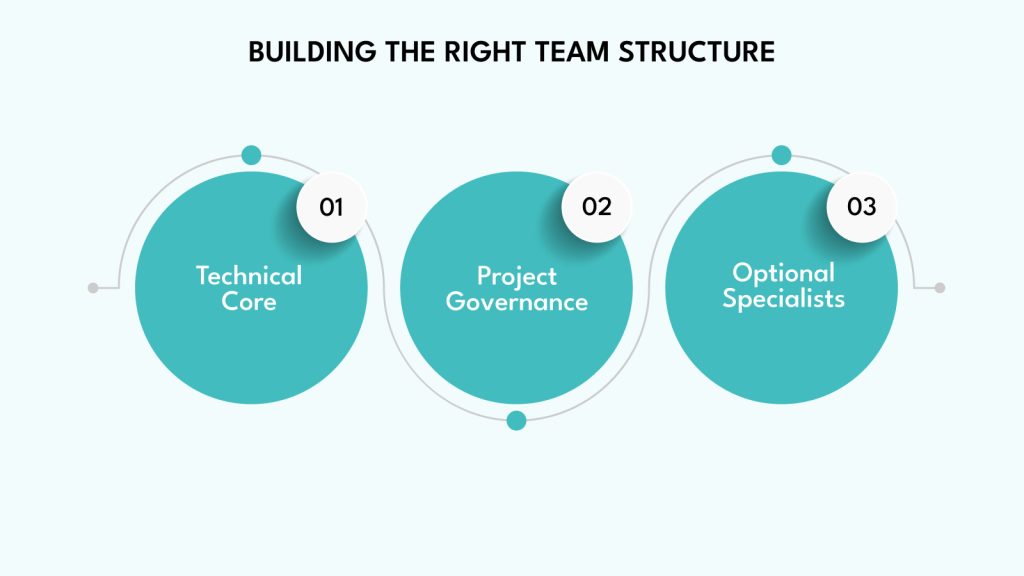
Dedicated teams should not be generic resource pools. Structure matters. The team composition must reflect your product’s architecture, stage of development, compliance needs, and integration demands.
Technical Core
Frontend developers build dynamic interfaces using React, Vue, or similar frameworks. They bring strong knowledge of modern state management, component architecture, and performance optimization. These engineers work directly with your design system and maintain consistency with existing user interfaces.
Backend developers specialize in Node.js, Django, Python, and .NET, with a focus on developing scalable APIs, processing data, and implementing system logic. They integrate with your microservices architecture, manage database schemas, and ensure API consistency across services.
DevOps engineers handle CI/CD automation, containerization, and infrastructure as code across AWS, Azure, or GCP. They maintain deployment pipelines, monitor system performance, and enforce security compliance across environments.
Project Governance & Quality
Project governance and quality require distinct roles with clear responsibilities. Technical leads handle architectural decisions, conduct code reviews, and guide system-level design. They act as a bridge between your internal architecture team and the dedicated developers, ensuring all decisions align with long-term technical goals.
Project managers oversee agile delivery, track timelines, and manage communication. They coordinate with your product managers, maintain sprint cadence, and ensure that deliverables meet acceptance criteria.
QA engineers build automation frameworks, expand regression coverage, and safeguard release quality by aligning test strategies with your existing quality processes and maintaining standards throughout the development lifecycle.
Optional Specialists
Depending on the product domain, you may also need:
- Security Engineers for HIPAA, SOC 2, or PCI DSS readiness. They conduct security reviews, implement compliance controls, and ensure data handling meets regulatory requirements.
- Data Engineers for analytics platforms, ML pipelines, or intelligent automation. They develop data processing workflows, ensure data quality, and support business intelligence needs.
The right mix depends on your current phase, ranging from starting from scratch to improving your MVP or preparing for scale. Early-stage products often need a lean team of 2–3 full-stack developers. In contrast, mature products typically call for specialized roles focused on performance optimization, security hardening, or advanced analytics.
Understanding the Economics: Dedicated vs In-House Teams
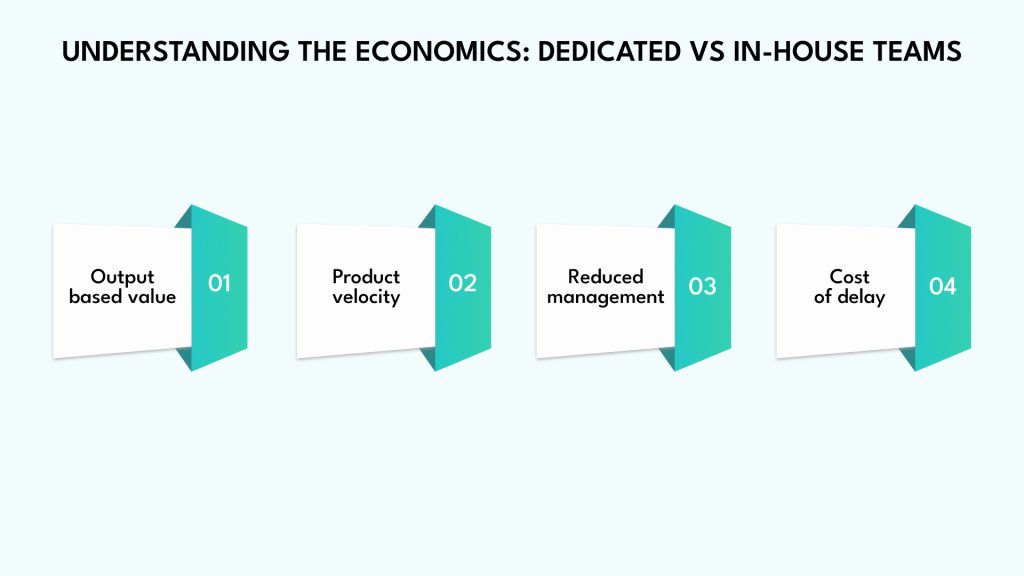
Many think dedicated teams are just a cheaper option. But cost is only one part of it. The real issue is, what is the cost of delays or poor-quality work?
To break this down further, let us compare the actual cost structure of dedicated teams versus in-house hiring.
Total Cost of Ownership Analysis
| Cost Factor | In-House Team | Dedicated Team Model |
| Base Salary (Senior Dev) | $160K–$200K | $80K–$120K |
| Overhead (Benefits, Admin) | 30–40% ($48K–$80K) | Included in vendor pricing |
| Time to Productivity | 2–3 months onboarding, 6 months full ramp-up | 2–3 weeks with pre-aligned practices |
| Recruiting Cost | $15K–$30K per hire | None |
| Equipment & Software | Company-provided | Handled by vendor |
| Administrative Burden | High (HR, payroll, performance reviews) | Minimal |
| Flexibility | Slower, depends on internal approvals and resources | Fast, scale teams up or down on demand |
| Talent Access | Limited to the local market | Global talent pool |
This table gives a snapshot view. Here is what the table does not capture and why it matters:
- Output-based value: Dedicated teams focus on delivery. You pay for working software, not for time spent on onboarding or HR processes. This shift moves the economic value from inputs to outcomes.
- Product velocity: Internal hires, even when skilled, take time to align with your processes and priorities. A dedicated team arrives aligned and often brings relevant domain experience, helping you gain traction faster.
- Reduced management load: With in-house teams, your senior staff spends hours each week on coaching, check-ins, and reviews. Dedicated models include senior tech leads who drive daily delivery, reducing oversight burden.
- Cost of delay: This is the silent killer. Every month spent hiring or onboarding internally is a month lost on market responsiveness. That lost opportunity has a real revenue impact, especially in fast-moving sectors.
Addressing Common Concerns About Dedicated Teams
Despite clear advantages, dedicated development teams often prompt questions about communication, oversight, and alignment. These concerns are valid, especially for organizations that have dealt with vendors lacking transparency or structured collaboration.
A well-run, dedicated team model addresses these challenges head-on. Let us examine how these setups work in practice, starting with communication.
Communication and Collaboration Effectiveness
Collaboration depends on how the team works, not where they are. The most effective dedicated team setups employ clear communication practices that provide greater clarity than many traditional in-house teams. These practices begin with daily check-ins that include both internal and dedicated team members, making sure everyone shares the same context and priorities.
The team sends regular written updates through dedicated Slack channels or Microsoft Teams workspaces, consistently sharing progress, key decisions, and blockers.
Documentation is a crucial component of how these teams operate. Shared tools like Confluence, Notion, or GitBook hold product requirements, technical details, and project updates in one place, so everyone has access to the same information. Planning sessions involve the dedicated team fully; they take part in setting goals, reviewing work, and improving processes, with equal input in technical decisions.
The primary difference is that remote setups necessitate more deliberate communication. But once in place, they often lead to better documentation, more transparent processes, and faster decision-making.
Code Quality and Standards
Quality concerns typically come from past experiences with low-cost offshore development. However, modern dedicated teams adhere to the same engineering standards as high-performing in-house teams. Trust is built through transparent processes and complete visibility.
One of the key foundations of that trust is code review. Both the dedicated team and your internal engineers review every piece of code before it is merged into the main codebase, ensuring consistency and accountability.
Automated testing is also built into the workflow. Tests run on every code change, with safeguards that prevent broken code from being deployed. Team members can access test results, bug reports, and other metrics that reflect the codebase’s overall health.
From the outset, the dedicated team follows your coding standards, documentation practices, and system design choices. They also align with your requirements for security, performance, and release steps, maintaining consistency across the entire product.
This structured approach to quality often produces better outcomes than internal teams operating without clear reviews or quality controls.
Intellectual Property and Data Security
Security is often a top concern when working with dedicated teams. However, experienced providers implement strict safeguards that often surpass those used by internal teams.
It starts with legal protections. Contracts include clear terms around confidentiality, ownership, and data protection. These cover non-disclosure agreements (NDAs), intellectual property rights, and guidelines for handling project data.
On the operational side, here are two core areas where mature providers focus to keep your systems and data secure:
- Data handling: Providers define and enforce clear rules on where they store data, how they use it, and how they back it up. They also support industry-specific regulations such as GDPR, HIPAA, and PCI-DSS.
- Ongoing reviews: Regular security checks, audits, and testing help maintain system security throughout the engagement.
Technical controls are built into everyday workflows. Teams access only the tools and data required for their role. Each environment utilizes separate logins, which are regularly updated and monitored to track access at every level.
Scalability and Flexibility
One of the key advantages of dedicated teams is the ability to scale development quickly, especially when growth accelerates or product priorities change. Traditional hiring can take months, but dedicated teams can onboard skilled developers within one to two weeks.
Here are two ways dedicated teams make that flexibility easier to manage:
- Expansion flexibility: You can add developers temporarily during high-demand periods or grow the team long-term as the product scales. There are no delays or commitments beyond those outlined in the contract.
- Reduction flexibility: If priorities shift or budgets tighten, you can reduce team size without the overhead of layoffs or internal HR processes.
This model also supports changes in focus. For example, a team can start with frontend specialists and later shift toward backend or DevOps talent as the product matures and infrastructure expands. They can also pivot quickly to support new features or technical goals without slowing down their recruitment efforts.
For startups and growth-stage companies, this kind of flexibility is critical. When funding, market conditions, or customer feedback change, the team can adapt without losing momentum.
Vendor Evaluation: Separating Quality from Marketing
The dedicated team market ranges from high-caliber engineering firms to basic staffing agencies, making vendor selection a critical task. While many vendors advertise “dedicated teams,” what they deliver often amounts to unstructured staff augmentation, lacking technical leadership and oversight. Identifying real capability requires looking beyond websites and sales decks to assess the depth of delivery and operational maturity.
The evaluation should focus on whether the vendor can deliver a coordinated engineering capacity, not just individual expertise. Strong providers demonstrate an end-to-end understanding of the software development lifecycle, including requirements, architecture, development, testing, and long-term maintenance. They offer senior technical leads who contribute to architecture reviews, code quality, and strategic decisions.
Before engagement, it is important to check for these warning signs:
- Lack of senior oversight: Vendors that fail to assign a named technical lead or architect often struggle with coordination, decision-making, and accountability.
- No clear delivery process: The absence of sprint planning, code review structure, or project management support typically signals an unmanaged contractor pool rather than a truly dedicated team.
Other concerns often emerge in capability claims. Vendors who say their teams can “work on any tech stack” usually lack depth in critical areas. Specialized knowledge matters, especially in regulated industries, complex system integrations, or performance-critical environments.
One of the simplest ways to assess maturity is through communication structure. Professional vendors clearly outline points of contact, escalation paths, and communication channels from day one.
Reliable vendors often share a few core traits:
- Proven technical leadership with domain-relevant experience and solid references from similar companies
- Documented delivery processes, including engineering practices, QA workflows, and project management that align with client operations
- Verified security posture, with certifications like SOC 2 or ISO 27001 and compliance experience in regulated sectors
Cultural fit also plays a role. The strongest partnerships emerge from teams that understand the realities of working with companies of a similar size and growth stage and can align with specific product, market, and compliance challenges.
Choosing the right partner shapes more than delivery speed; it affects long-term product quality, team alignment, and engineering trust. The right dedicated team brings technical leadership, domain depth, and the ability to plug into existing workflows without friction.
If that is the kind of team you are looking for, schedule a consultation call to gain clarity.
Management Best Practices for Long-Term Success
Long-term success with dedicated teams depends on treating them as strategic partners. That starts with clear operating structures, shared accountability, and a focus on outcomes that align with business goals.
Strong partnerships are built when internal and external team members work toward the same objectives, follow consistent communication routines, and uphold shared quality standards.
Performance should be measured by the value delivered. Listed below are some metrics you can look out for:
- Delivery metrics: Track sprint velocity, story completion, and cycle time from development to deployment. These give insight into how reliably work moves through the pipeline.
- Quality metrics: Monitor defect rates, test coverage, and time taken to fix bugs to ensure stability is not sacrificed for speed.
- Collaboration metrics: Evaluate how the partnership is functioning, including the time to onboard new members, the frequency of cross-team knowledge sharing, and satisfaction levels among stakeholders.
These metrics should be reviewed regularly in joint retrospectives, where both teams collaborate to drive process improvements.
Communication must be deliberate and documented. Weekly technical demos help gather feedback, while architecture reviews, held every two weeks, keep systems aligned with long-term goals.
Strategic planning deserves its own space. Monthly sessions should focus on roadmap alignment, team planning, and the overall health of the relationship.
- Documentation: Shared tools should house product specifications, technical decisions, and backlog context, which should be kept up to date by both teams.
- Escalation paths: Clearly defined steps help resolve issues early, whether they involve technical direction, bandwidth conflicts, or communication gaps.
Dedicated team members proactively drive technical improvements and suggest process refinements, which are signs of genuine integration. This autonomy enables internal teams to focus on strategic priorities while maintaining confidence in the quality of delivery and timelines.
Financial Planning and Budget Forecasting
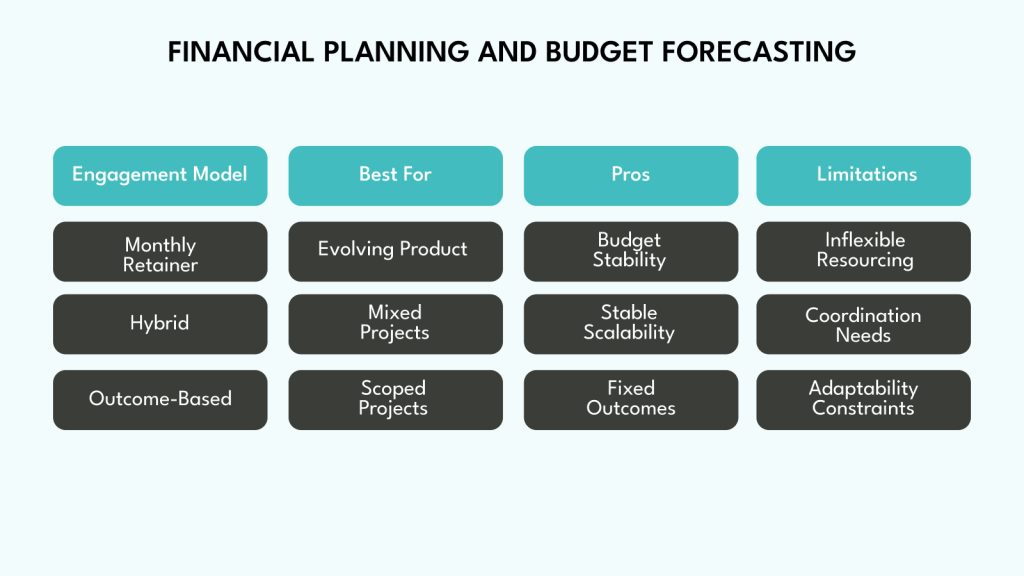
Planning costs for dedicated teams involves more than comparing hourly rates. To budget effectively, it is essential to consider scalability, retention, tooling, and overall delivery spend. Focusing solely on the rate per developer gives an incomplete picture.
Different engagement models offer different trade-offs. The right one depends on product maturity, resource predictability, and the pace of change.
Here is a quick comparison of the three most common models:
| Engagement Model | Best For | Pros | Limitations |
| Monthly Retainer | Long-term, evolving product development | Predictable budget, guaranteed availability | Less flexible during low-demand periods |
| Hybrid | Variable needs, mixed project loads | Base team stability + on-demand scaling | Requires coordination across fixed + flex teams |
| Outcome-Based | Defined-scope projects with fixed deliverables | Clear deliverables, fixed cost per result | Less adaptable to changing priorities |
This model selection sets the foundation, but a complete financial plan must also look beyond the engagement structure itself.
- Seniority mix: Blending senior and mid-level developers helps strike a balance between cost and quality.
- Tooling expenses: Add monitoring tools, test environments, and infrastructure platforms into your budget.
- Built-in management overhead: Account for project managers and tech leads as part of the base cost, not add-ons.
Scalability terms matter, too. Some providers have minimum duration commitments or notice periods for reducing team size, both of which affect flexibility and financial planning.
Costs also shift over time. The first year often includes onboarding, tooling setup, and process alignment, making it the most expensive. As the team stabilizes, delivery becomes faster and more efficient, bringing down the per-sprint or per-feature cost.
Finally, compare long-term opportunity costs. A team that speeds up releases and reduces hiring delays can significantly cut time-to-market. The financial value they bring often goes well beyond the sticker price.
Strategic Planning: Aligning Teams with Product Roadmaps
Dedicated teams work best when their structure mirrors the evolution of the product. However, companies often bring them in for execution without rethinking how their role, size, or skill set should evolve as the roadmap progresses.
This disconnect becomes apparent when a team built for fast prototyping is asked to manage scale or when specialists are added too late after systems start to break under pressure. Strategic planning prevents these gaps by adjusting team composition and responsibilities as product goals evolve.
To keep the team aligned with changing priorities, match structure and expertise to the demands of each product phase:
- Prototype to MVP: At this stage, lean teams of 2–3 full-stack developers maintain a fast and flexible approach. The goal is to validate core features, not perfect them. Quick iteration, close coordination with product leads, and minimal process overhead work best here.
- MVP to Product-Market Fit: As complexity grows, so should the team. DevOps engineers help stabilize deployments. QA adds consistency. A UX role may come in to sharpen onboarding or usability as user volume increases. The team shifts from building “what works” to building “what lasts.”
- Post-PMF and Scaling: The focus now shifts to performance, security, and integrations. Specialized roles, like backend engineers, compliance experts, or integration leads, ensure the system can support scale, meet audit requirements, and connect with enterprise environments.
Strategic alignment also depends on how teams participate in key decisions:
- Tech direction and architecture: Senior members from the dedicated team should contribute to architecture reviews and system planning. Their experience strengthens decision quality and platform stability.
- Roadmap and delivery planning: Availability, skill fit, and delivery history should shape sprint velocity and release targets. This keeps planning grounded and realistic.
- Ongoing knowledge exchange: Shared documentation, regular technical syncs, and internal walkthroughs help prevent bottlenecks and knowledge silos, ensuring long-term alignment across teams.
As product maturity sets in, roles may shift. Dedicated teams can move from building new features to handling optimization and maintenance, while internal teams refocus on long-term bets. But this transition works only when it is intentional and mapped out.
The team structure is a continuous decision shaped by product shifts, technical goals, and delivery needs at every stage.
Risk Management and Contingency Planning
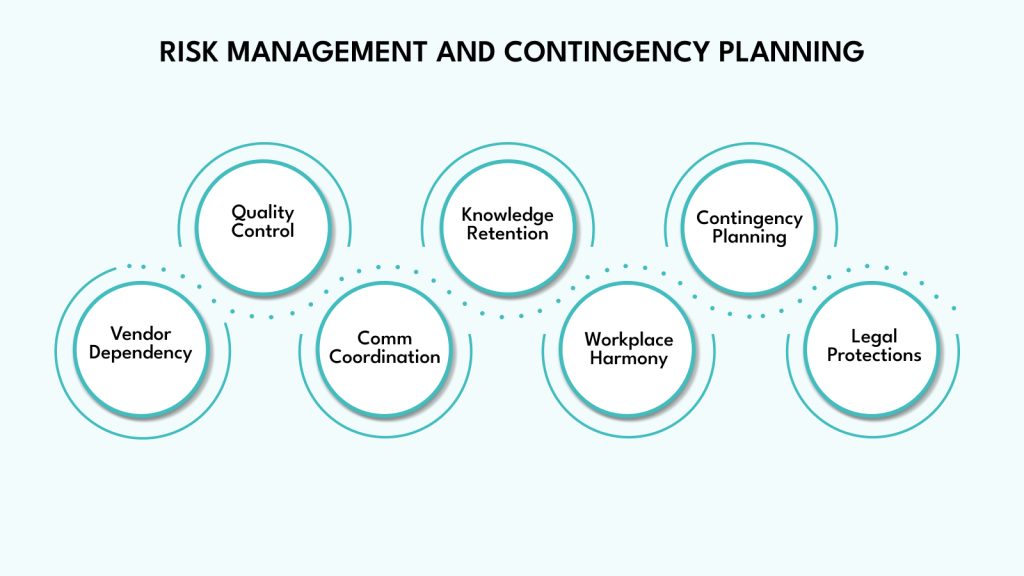
Every strategic decision carries risk, and adopting a dedicated team model is no different. The key is not to avoid risk but to prepare for it with systems that protect delivery, quality, and continuity even when unexpected issues arise.
In this section, we will outline the major risk areas and how to manage them effectively:
Vendor Dependency: Relying too heavily on a single external provider creates significant exposure. If the relationship breaks down or performance drops, core product work could be at risk.
To reduce this:
- Avoid single-vendor setups for critical systems.
- Keep key architectural and business logic documentation under internal control.
- Start with non-critical modules before assigning core systems.Quality Control: Less direct oversight can lead to hidden technical debt, bugs, or security issues that surface later.
Safeguards include:
- Keeping all source code under internal version control systems.
- Running periodic code audits by internal architects or third-party experts.
- Tracking delivery speed, code quality, and feedback scores to spot issues early.
Communication and Coordination: Without clear expectations, collaboration can break down, causing delays or misaligned work.
Solidify communication by:
- Including clear SLAs for responsiveness, reporting, and escalation in contracts.
- Scheduling regular operational reviews focused on process health, not just output.
Ensure that:
- Documentation is actively maintained and accessible to internal teams.
- Decisions and logic are recorded and reviewed regularly.
Cultural Fit and Team Dynamics: Misalignment in work style or values can hurt morale and slow delivery. Reduce this risk by assessing fit early, during the onboarding and initial collaboration phases, and then adjusting teams if needed.
Contingency Planning: Risk is not always a failure; it could be a sudden pivot, a change in budget, or a team member leaving.
Prepare by:
- Outlining fallback scenarios and what actions to take in each.
- Keeping optional vendors and capacity on standby.
- Evaluating which capabilities must stay in-house under any condition.
Financial and Legal Protections: Clarity here prevents confusion later.
Focus on:
- Clear contract terms for pricing, payment schedules, exit clauses, and penalties.
- IP protection, confidentiality coverage, and liability terms that safeguard business interests.
Risk cannot be eliminated, but it can be managed. The strongest dedicated team partnerships are built on resilience: planning for what could go wrong while staying focused on what needs to go right.
How to Choose the Right Team Based on Your Tech Stack
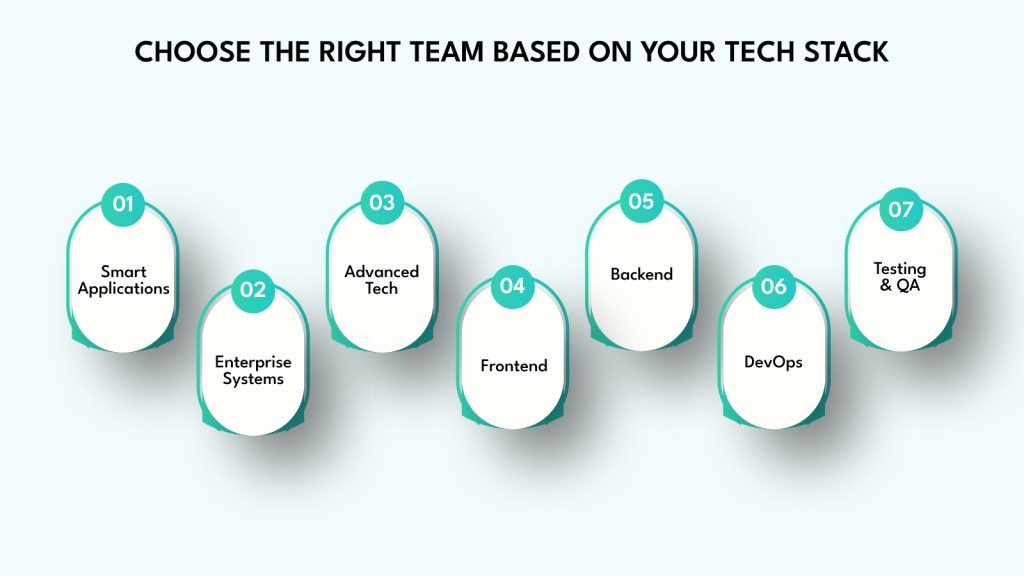
The technology you build shapes the kind of team you need. A developer who excels in React and microservices might struggle in a . NET-heavy enterprise system and vice versa. Choosing a dedicated team without aligning it to your tech environment leads to delays, rework, and quality issues down the line.
Different stacks come with different priorities and constraints. Here is how the needs change depending on what you are building:
- Modern Web Applications (React, Node.js, etc.): Web apps need teams that understand both the frontend and backend depth:
- On the front end: state management, performance, responsive UI behavior, and reusable component design.
- On the backend: scaling APIs, handling async operations, and optimizing database queries.
Teams also need experience with cloud hosting, CI/CD, and real-time monitoring to support fast iterations.
- Enterprise Systems (.NET, Java, traditional databases): Older enterprise environments need more than just technical skill; they demand maturity:
- Developers must understand how to work with large, complex legacy systems.
- Integration often involves working around existing infrastructure without breaking it.
- Compliance, auditability, and long-term stability matter more than speed.
This means the team must be comfortable with slower cycles, rigorous documentation, and change management.
- AI, Blockchain, IoT, or Other Emerging Tech: Cutting-edge products bring uncertainty. The team must:
- Balance innovation with reliability; what works in a lab must hold up in production.
- Know how to validate experimental features quickly.
- Have experience shipping working solutions, not just prototypes or research code.
Regardless of the stack, there are four areas that always need to match the project context:
- Frontend: Is the team experienced with your framework (React, Angular, etc.) and toolchain? Can they write fast, accessible, maintainable interfaces?
- Backend: Do they follow scalable architectural patterns that fit your app, monolith, microservices, event-driven, etc.? Can they ensure performance under load?
- DevOps: Can the team work with your infrastructure, Kubernetes, VMs, and hybrid setups? Can they plug into your CI/CD, monitoring, and rollback tools?
- Testing and QA: Is the team’s testing approach suitable for your product? Browser-based apps, regulated platforms, and ML-driven products all need different QA practices.
Failing to match team capabilities with your tech environment adds risk you can avoid. The stronger the alignment between your stack and their experience, the smoother the delivery and the fewer surprises when real users come in.
If you are thinking about testing dedicated teams against the choices above, talk to us. We will give you a clear view of what works, what doesn’t, and how to move forward with confidence.
How to Get QA Right in Dedicated Team Models
Once the right team is aligned with your tech environment, the next priority is delivery quality, specifically how testing ensures stability, speed, and confidence as the product evolves.
Strong, dedicated teams stand out by embedding quality at every stage of development, not just at the end. Their testing strategy must align with your internal processes while upholding consistency in code quality, reliability, and user experience.
The right QA setup covers three areas: automation, manual testing, and measurable quality indicators.
Automated testing sets the baseline for long-term quality. This includes:
- Unit tests with defined code coverage thresholds
- Integration tests to check APIs, databases, and third-party services
- End-to-end tests that simulate user actions to catch regressions
Manual testing fills in what automation misses. This includes:
- Exploratory testing for edge cases and unexpected user behavior
- Usability reviews across devices and browsers
- Performance checks to measure load handling and system response under pressure
Quality metrics make results visible and trackable:
- Defect trends: how many bugs are found, how quickly they are fixed, and why they appear
- Test coverage: where tests exist, where they do not, and how that affects stability
- Post-release issues: what gets missed, how it impacts users, and what needs to be improved
These metrics should be reviewed regularly to improve processes and keep standards high as the product grows.
Close coordination between the dedicated team and your internal QA processes is essential. Without it, standards drift, or gaps appear. With it, the result is a shared quality culture where both teams work toward the same definition of done.
Final Thoughts!
Dedicated development teams are becoming the backbone of high-performing software organizations. But the model only works when the team involved is deeply accountable, technically sound, and aligned with real business goals.
At DEVtrust, we act as your embedded engineering team. We solve problems, write production-ready code, and think beyond the ticket. Every decision we make connects directly to how your product performs and scales. That means fewer handovers, fewer blind spots, and no need to micromanage delivery.
When you work with us, you are not managing a vendor. You are working with a team that treats your software like its own.
If you are considering the dedicated model, we are ready to show you what that looks like in practice. Book a call.
Dedicated Development Teams: Complete Guide for Scaling in 2025
Hire a dedicated development team to access specialized skills and global talent. Boost your 2025 strategy with scalable, cost-efficient solutions. Discover now!
Contact Us